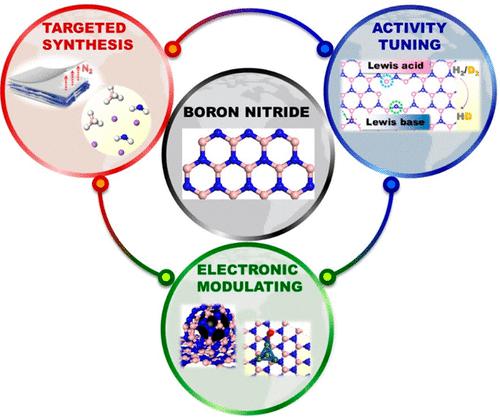当前位置:
X-MOL 学术
›
Acc. Chem. Res.
›
论文详情
Our official English website, www.x-mol.net, welcomes your feedback! (Note: you will need to create a separate account there.)
Engineering Nanostructured Interfaces of Hexagonal Boron Nitride-Based Materials for Enhanced Catalysis
Accounts of Chemical Research ( IF 18.3 ) Pub Date : 2022-11-15 , DOI: 10.1021/acs.accounts.2c00564 Hao Chen 1, 2 , De-En Jiang 3 , Zhenzhen Yang 4 , Sheng Dai 1, 4
Accounts of Chemical Research ( IF 18.3 ) Pub Date : 2022-11-15 , DOI: 10.1021/acs.accounts.2c00564 Hao Chen 1, 2 , De-En Jiang 3 , Zhenzhen Yang 4 , Sheng Dai 1, 4
Affiliation

|
Hexagonal boron nitrides (h-BNs) are attractive two-dimensional (2D) nanomaterials that consist of alternating B and N atoms and layered honeycomb-like structures similar to graphene. They have exhibited unique properties and promising application potentials in the field of energy storage and transformation. Recent advances in utilizing h-BN as a metal-free catalyst in the oxidative dehydrogenation of propane have triggered broad interests in exploring h-BN in catalysis. However, h-BN-based materials as robust nanocatalysts in heterogeneous catalysis are still underexplored because of the limited methodologies capable of affording h-BN with controllable crystallinity, abundant porosity, high purity, and defect engineering, which played important roles in tuning their catalytic performance. In this Account, our recent progress in addressing the above issues will be highlighted, including the synthesis of high-quality h-BN-based nanomaterials via both bottom-up and top-down pathways and their catalytic utilization as metal-free catalysts or as supports to tune the interfacial electronic properties on the metal nanoparticles (NPs). First, we will focus on the large-scale fabrication of h-BN nanosheets (h-BNNSs) with high crystallinity, improved surface area, satisfactory purity, and tunable defects. h-BN derived from the traditional approaches using boron trioxide and urea as the starting materials generally contains carbon/oxygen impurities and has low crystallinity. Several new strategies were developed to address the issues. Using bulk h-BN as the precursor via gas exfoliation in liquid nitrogen, single- or few-layered h-BNNS with abundant defects could be generated. Amorphous h-BN precursors could be converted to h-BN nanosheets with high crystallinity assisted by a magnesium metallic flux via a successive dissolution/precipitation/crystallization procedure. The as-fabricated h-BNNS featured high crystallinity and purity as well as abundant porosity. An ionothermal metathesis procedure was developed using inorganic molten salts (NaNH2 and NaBH4) as the precursors. The h-BN scaffolds could be produced on a large scale with high yield, and the as-afforded materials possessed high purity and crystallinity. Second, utilization of the as-prepared h-BN library as metal-free catalysts in dehydrogenation and hydrogenation reactions will be summarized, in which they exhibited enhanced catalytic activity over the counterparts from the previous synthesis method. Third, the interface modulation between metal NPs with the as-prepared defects’ abundant h-BN support will be highlighted. The h-BN-based strong metal–support interaction (SMSI) nanocatalysts were constructed without involving reducible metal oxides via the ionothermal procedure we developed by deploying specific inorganic metal salts, acting as robust nanocatalysts in CO oxidation. Under conditions simulated for practical exhaust systems, promising catalytic efficiency together with high thermal stability and sintering resistance was achieved. Across all of these examples, unique insights into structures, defects, and interfaces that emerge from in-depth characterization through microscopy, spectroscopy, and diffraction will be highlighted.
中文翻译:

用于增强催化作用的六方氮化硼基材料的工程纳米结构界面
六方氮化硼 (h-BN) 是一种极具吸引力的二维 (2D) 纳米材料,由交替的 B 和 N 原子以及类似于石墨烯的层状蜂窝状结构组成。它们在储能和转换领域展现出独特的性能和广阔的应用潜力。利用 h-BN 作为丙烷氧化脱氢中的无金属催化剂的最新进展引发了人们对探索 h-BN 在催化中的广泛兴趣。然而,h-BN 基材料作为多相催化中的稳健纳米催化剂仍未得到充分探索,因为能够提供具有可控结晶度、丰富的孔隙率、高纯度和缺陷工程的 h-BN 的方法有限,这在调整其催化方面发挥了重要作用表现。在这个帐户中,我们最近在解决上述问题方面取得的进展将得到强调,包括通过自下而上和自上而下的途径合成高质量的 h-BN 基纳米材料,以及它们作为无金属催化剂的催化利用或作为载体来调节金属纳米粒子 (NPs) 的界面电子特性。首先,我们将专注于大规模制造具有高结晶度、改进的表面积、令人满意的纯度和可调缺陷的 h-BN 纳米片 (h-BNNS)。以三氧化硼和尿素为起始原料的传统方法衍生的h-BN通常含有碳/氧杂质并且结晶度低。为解决这些问题制定了多项新战略。使用块状六方氮化硼作为前体,通过液氮中的气体剥离,可以生成具有大量缺陷的单层或几层 h-BNNS。无定形 h-BN 前体可以通过连续的溶解/沉淀/结晶过程在镁金属助熔剂的帮助下转化为具有高结晶度的 h-BN 纳米片。制造的 h-BNNS 具有高结晶度和纯度以及丰富的孔隙率。使用无机熔盐(NaNH2和 NaBH 4) 作为前体。h-BN支架可以大规模生产,产率高,所提供的材料具有高纯度和结晶度。其次,将总结所制备的 h-BN 库作为脱氢和加氢反应中的无金属催化剂的应用,其中它们表现出比先前合成方法的对应物更高的催化活性。第三,将突出金属 NPs 与制备缺陷丰富的 h-BN 支持之间的界面调制。基于 h-BN 的强金属-载体相互作用 (SMSI) 纳米催化剂是在不涉及可还原金属氧化物的情况下通过我们通过部署特定无机金属盐开发的离子热程序构建的,在 CO 氧化中充当稳健的纳米催化剂。在为实际排气系统模拟的条件下,实现了有前途的催化效率以及高热稳定性和耐烧结性。在所有这些示例中,将重点介绍通过显微镜、光谱学和衍射进行深入表征而产生的对结构、缺陷和界面的独特见解。
更新日期:2022-11-15
中文翻译:

用于增强催化作用的六方氮化硼基材料的工程纳米结构界面
六方氮化硼 (h-BN) 是一种极具吸引力的二维 (2D) 纳米材料,由交替的 B 和 N 原子以及类似于石墨烯的层状蜂窝状结构组成。它们在储能和转换领域展现出独特的性能和广阔的应用潜力。利用 h-BN 作为丙烷氧化脱氢中的无金属催化剂的最新进展引发了人们对探索 h-BN 在催化中的广泛兴趣。然而,h-BN 基材料作为多相催化中的稳健纳米催化剂仍未得到充分探索,因为能够提供具有可控结晶度、丰富的孔隙率、高纯度和缺陷工程的 h-BN 的方法有限,这在调整其催化方面发挥了重要作用表现。在这个帐户中,我们最近在解决上述问题方面取得的进展将得到强调,包括通过自下而上和自上而下的途径合成高质量的 h-BN 基纳米材料,以及它们作为无金属催化剂的催化利用或作为载体来调节金属纳米粒子 (NPs) 的界面电子特性。首先,我们将专注于大规模制造具有高结晶度、改进的表面积、令人满意的纯度和可调缺陷的 h-BN 纳米片 (h-BNNS)。以三氧化硼和尿素为起始原料的传统方法衍生的h-BN通常含有碳/氧杂质并且结晶度低。为解决这些问题制定了多项新战略。使用块状六方氮化硼作为前体,通过液氮中的气体剥离,可以生成具有大量缺陷的单层或几层 h-BNNS。无定形 h-BN 前体可以通过连续的溶解/沉淀/结晶过程在镁金属助熔剂的帮助下转化为具有高结晶度的 h-BN 纳米片。制造的 h-BNNS 具有高结晶度和纯度以及丰富的孔隙率。使用无机熔盐(NaNH2和 NaBH 4) 作为前体。h-BN支架可以大规模生产,产率高,所提供的材料具有高纯度和结晶度。其次,将总结所制备的 h-BN 库作为脱氢和加氢反应中的无金属催化剂的应用,其中它们表现出比先前合成方法的对应物更高的催化活性。第三,将突出金属 NPs 与制备缺陷丰富的 h-BN 支持之间的界面调制。基于 h-BN 的强金属-载体相互作用 (SMSI) 纳米催化剂是在不涉及可还原金属氧化物的情况下通过我们通过部署特定无机金属盐开发的离子热程序构建的,在 CO 氧化中充当稳健的纳米催化剂。在为实际排气系统模拟的条件下,实现了有前途的催化效率以及高热稳定性和耐烧结性。在所有这些示例中,将重点介绍通过显微镜、光谱学和衍射进行深入表征而产生的对结构、缺陷和界面的独特见解。


























 京公网安备 11010802027423号
京公网安备 11010802027423号